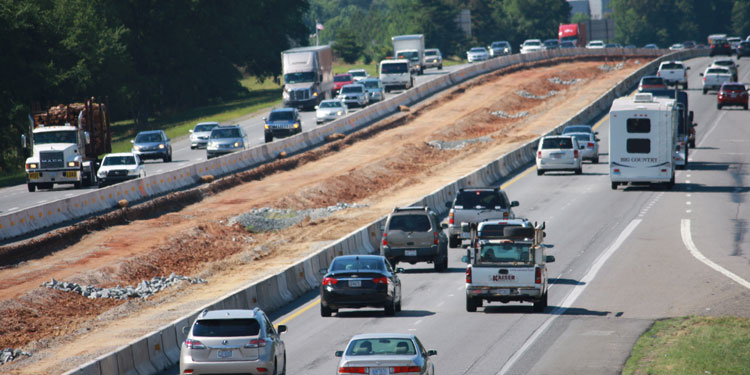
By Dave Vieser. Even while the I-77 toll lane project continues to face significant opposition, the NCDOT has been quick to say more than $150 million in bonus allocation funds has been earmarked for the North Mecklenburg/Iredell County region. That seems to be quite a stretch, with some Huntersville officials questioning their effectiveness in reducing congestion.
Meanwhile, the NCDOT has apparently ignored letters from the Cornelius and Huntersville town boards asking, among other things, for an economic impact study for the managed lanes. Without a study, the project should not go forward, the Cornelius letter said.
RELATED: I-77 toll lanes won’t survive the ‘chorus of discontent’
“It was more than disappointing that Cornelius did not get a response or even an acknowledgement to what I thought was a respectful, thorough and well-written document which was signed by all the elected officials in our Town,” said Mayor Pro Tem Woody Washam.
The Cornelius board also asked that trucks be allowed to use the toll lanes, thereby reducing congestion on general purpose lanes.
The NCDOT also did not respond to Huntersville’s letter—even though they requested it. “They gave us two weeks to respond and now it’s about six months and we’ve heard nothing back,” said Huntersville Mayor John Aneralla.
The bonus allocation funds—called “bribe” money by critics—are looking more and more like a phony come-on, too.
“It was pretty clear from the start that the bonus funds were given to our region as an incentive to accept the toll lanes,” said Anarella. But about half—$75 million—will be used strictly for toll lane projects: direct access ramps at the Hambright Road bridge in Huntersville, and the Lakeview Road bridge, which is just south of the Charlotte/Huntersville border.
“I really think it’s rather disingenuous for the DOT to give the impression that the bonus allocation was a bag of new money,” said Mecklenburg County Commissioner Jim Puckett, who represents District One, the north side of the county. “Most of the projects being funded were in the pipeline already; the bonus funds simply moved them up.”
Puckett said more than half of the funds are for two direct access ramps on I-77. “Those ramps wouldn’t be needed if the toll lanes weren’t being built,” he said.
The direct access ramps are needed so that motorists traveling on the toll lanes, which are the inside lanes, won’t have to cross several lanes of traffic to reach the traditional exits.
When contacted by Business Today, DOT’s Warren Cooksey said that the decision on which projects would be funded by the Bonus Allocation funds was actually made by CRTPO (Charlotte Regional Transportation Planning Organization). “CRTPO worked on the bonus allocation issue in several meetings in 2014 and 2015, and the vote to fund the direct access ramp connectors occurred on March 18, 2015,” Cooksey said. The vote was unanimous, including a “yes” vote cast by Huntersville’s representative on the CRTPO, Town Commissioner Sarah McAulay.
McAulay was soundly defeated for re-election in the fall.
Huntersville officials also feel the money could be used in a more effective manner. “The benefit of these funds is very limited because the toll lanes won’t carry commercial vehicles,” said Huntersville Mayor Pro Tem Danny Phillips. “I would rather see the funds used to improve and, if appropriate, widen Highway 21. We need to apply those bonus funds in a manner which will have the most impact on reducing congestion.”
As for stopping the toll lane project itself, town officials aren’t ready to give up, but they aren’t optimistic either.
“Our only real hope is that some new legislation will emerge in next Spring’s long session, but I’m not sure what could change to the extent that a project cancellation bill makes it to the floor of both houses next year when it couldn’t this spring,” Aneralla said.
Puckett said this: “I think I-77 will have to wait for a new governor and only if we can get him to promise to cancel before he is elected so we have some chance of holding him to it.”
No response: Concerns posed by Huntersville, Cornelius
Back in February NCDOT Secretary Nick Tennyson made news by asking for input on the contract with Cintra to widen I-77 between Lake Norman and Charlotte. John Aneralla, mayor of Huntersville, and Woody Washam, mayor pro tem of Cornelius, say the NCDOT never got back to them. The letter from the Cornelius town board is seven pages long; Huntersville, two pages. Here are excerpts. Click here to view the PDF of the entire letter.
Huntersville
Will high occupancy vehicles without a transponder be charged a toll? How will this happen? If “yes”, why must high occupancy vehicles purchase a transponder in order to use the lanes for “free”? What is the cost of purchasing and maintaining this transponder?
The contract contains extensive provisions for taxpayer compensation in the event of developer default. Please explain how the contract “fully protects taxpayers of North Carolina” and how the North Carolina taxpayers are shielded “from any financial liability.”
Toll rates of “14 to 40 cents per mile” would equate to a toll of up to $20.80 round trip if a driver were to use the managed lane its entire 26 mile length. Please explain why the cost would not be “$20 to use the additional lanes.”
Please explain the purpose of a public comment period prior to setting toll rates. It is our understanding that I77 Mobility Partners has been granted the unfettered right to set toll rates and therefore does not require any governmental approval or public comment.
In light of the Indiana Toll Road bankruptcy, the SH-130 technical bankruptcy, and the recent sale of the Chicago Skyway, please enumerate the Cintra projects in the U.S. that you consider to be successful, and what constitutes the definition of success.
Cornelius
In order to minimize the period of time that the facility is managed and operated by a private entity, reduce the term of the contract from 50 years to 25 years, utilizing approaches such as a buyout clause and/or a future conversion of the managed lanes to general purpose lanes.
It is desirable to have available as many future financially feasible I77 cross-section design options as possible (by keeping future overall costs as low as possible). Therefore, add clear language to the contract that states there shall be no financial penalty paid to I77 Mobility Partners (via a “compensation event”, triggering an “unplanned revenue impacting facility” designation, or otherwise) for the construction of any general purpose lanes along I77.
To allow greater travel options for all types of vehicles (including commercial vehicles), and to remove vehicles from the general purpose lanes flow of traffic, remove the managed lanes restriction of vehicles 20 feet in length and longer; thus allowing 18-wheel and tractor-trailer type vehicles to utilize the managed lanes.
Allow vehicles with at least two passengers to utilize the managed lanes at no cost.

The 800 lb gorilla on the road is the fact that none of these ideas will ever be accepted by CINTRA. The only way they make money is to absolutely make sure there is as much congestion as possible in the GP lanes. Without congestion, no one uses the toll lanes…
Posted by Jeff Costa | August 8, 2016, 4:08 pm